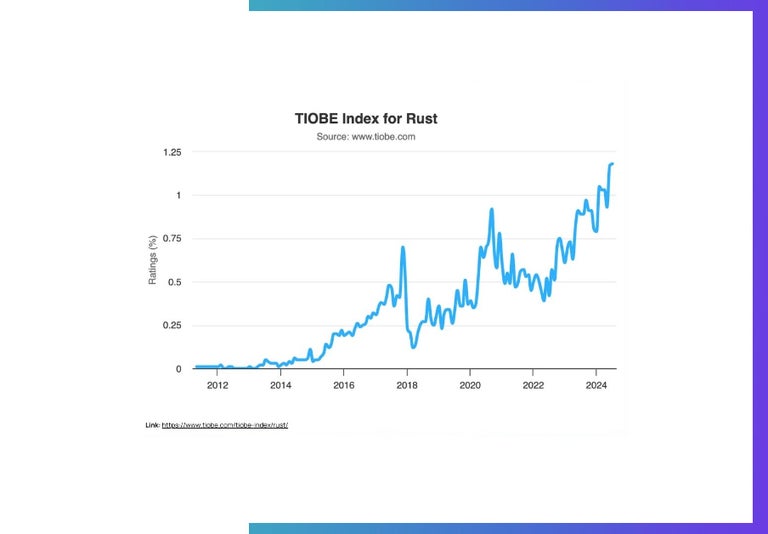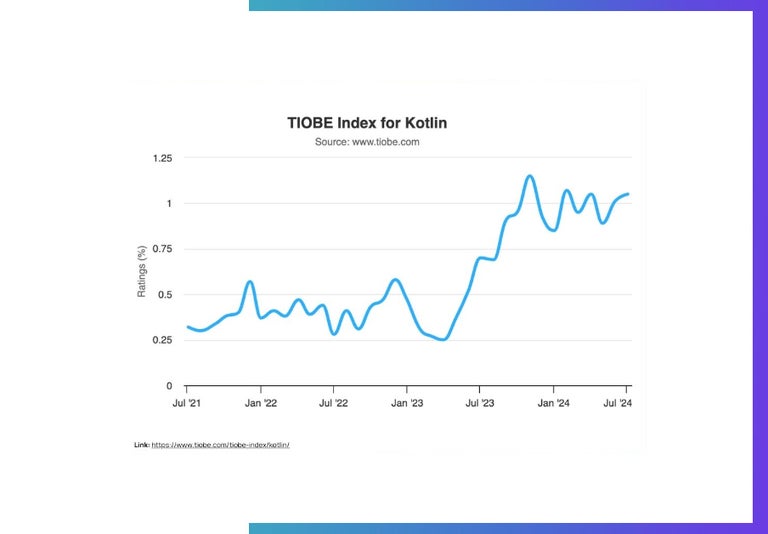Contents
- 1. Python: The Versatile Vanguard
- 2. C++: The High-Performance Heavyweight
- 3. Java: The Enterprise Backbone
- 4. C#: The Microsoft Ecosystem VIP
- 5. JavaScript: The Evolving Giant
- 6. Go (Golang): The Rising Star of Cloud Infrastructure
- 7. Rust: The Future of Systems Programming
- 8. Ruby: The Startup Accelerator
- 9. Swift: The iOS Developer
- 10. Kotlin: The Java Modernizer
- Charting Your Course in 2025
What will the top future programming languages for 2025 be? Whether you're a humble beginner or an established coder, mastering these key languages is your ticket to the tech elite.
Peer into our crystal ball and glimpse the future of coding. From AI integration to cloud-native development, these top 10 programming languages are on an upward curve. And they’re only gaining in popularity.
Let’s gaze into the swirling mists of our crystal compiler, for visions of 2025's programming winners.
The future, after all, is written in code.
But what does it say?
In this not-so-distant future, AI has evolved from buzzword to silent coding partner.
Cloud computing no longer looms over the horizon, it’s the very atmosphere surrounding us. And security? It's ascended from afterthought to the honored guest at every developer's table.
As some languages solidify their reigns, others are scaling the ranks with startling speed. These are the brick-and-mortar keystones of tomorrow's technology.
The languages that will elevate you to the top 1%.
The future of coding is about to be revealed.
Are you ready to hear it?
1. Python: The Versatile Vanguard
As we peer into the future of programming, Python stands as a dominant force.
In 2025, this language takes the lead, and others follow.
The PYPL PopularitY of Programming Language chart reveals Python's impressive performance. A commanding 29.6% market share, with a +1.7% one-year trend.
These numbers prove that Python’s continued significance is set in stone next year.
Why Python
- AI and Machine Learning: With AI projected to contribute $15.7 trillion to the global economy by 2030, Python's role in this field is undeniable. Its easy to learn syntax and powerful libraries like TensorFlow and PyTorch make it the go-to language for AI development. Whether you're building complex neural networks or implementing natural language processing, Python provides the tools you need.
- Data Science and Analytics: In a world awash with data, Python is an essential tool for making sense of it all. Its data manipulation and visualization libraries have revolutionized how we handle big data. From predictive analytics to intricate data visualizations, Python continues to be the language of choice for data scientists and analysts alike.
- Web Development: Python's reach extends beyond data and AI. Frameworks like Django and Flask push Python into the web development arena, especially for data-heavy applications. If you're looking to build scalable web apps that can handle complex data processing, Python offers a powerful solution.
Looking ahead to 2025, we can expect Python to lead the charge in AI-driven applications, powering data-driven decision-making, and making significant inroads in web development.
If you haven't added Python to your skill set yet, now is the time to start. And if you're already well versed, wading deeper will create more opportunities for you in the coming years.
2. C++: The High-Performance Heavyweight
C++ continues to stand tall as a titan of performance-critical applications. This language sets the standard for efficiency and control. Who doesn’t love C++?
Its consistent presence in the top ranks of language programming draws a line under its ongoing relevance in the world of tech.
Why C++ Matters
- Game Development: When it comes to creating immersive, graphically intensive games, C++ leads the pack. As the foundation of Unreal, it continues to blur the line between physical and fantastical. From AAA titles to emerging VR and AR experiences, C++ is the language bringing virtual worlds to life.
- Financial Systems: In the high-stakes world of financial trading, where milliseconds can mean millions, C++ is the go-to choice. Its speed and efficiency make it ideal for building robust, lightning-fast financial systems. If you're aiming to make your mark in fintech, C++ is your seat at the table.
- Embedded Systems: As the Internet of Things (IoT) expands, C++'s ability to work closely with hardware gives it a distinct edge. From smart home devices to industrial control systems, it's the force behind our increasingly connected world.
Looking towards 2025, C++'s combination of performance, control, and efficiency positions it at the forefront of systems programming, game development, and high-performance computing.
For those who want to craft blazingly fast, resource-efficient applications, C++ will continue to be an indispensable weapon in their arsenal.
3. Java: The Enterprise Backbone
Java maintains its position as a powerhouse in enterprise software. Despite a slight dip in market share (-0.3% one-year trend), Java's robust 15.6% share on the PYPL index - nearly double its closest competitor - speaks to its sustained impact in the corporate world.
Why Java Matters
- Cloud-Native Applications: Java's robust ecosystem and scalability make it a key player for building large, distributed systems. Its "write once, run anywhere" philosophy is well-suited for the diverse, cloud-centric environment of 2025. For developers looking to craft resilient, scalable cloud applications, Java is a valuable skill.
- Android Development: While Kotlin gains ground, Java's role in Android app creation remains strong. With the mobile app market projected to reach a staggering $777.4 billion by 2032, proficiency in Java opens doors to a vast (and lucrative) field of opportunities.
- Big Data Processing: Frameworks like Apache Hadoop and Apache Spark, key in big data ecosystems, are Java-based. As data continues its rolling stampede, Java's role in processing and analyzing massive datasets will become increasingly vital.
As we look to 2025, Java's evolution towards improved performance and modularity (via projects like Valhalla) suggests it will remain a key component of enterprise software development.
For those aiming to build robust, scalable applications that power businesses across the globe, Java will be a must-have in your programming toolkit.
4. C#: The Microsoft Ecosystem VIP
We see C# evolving from a Windows-centric language into a versatile, cross-platform powerhouse. Its growth is closely tied to the expanding Microsoft ecosystem and cloud services, positioning it as a key player in shaping enterprise software development.
C#'s consistent popularity and Microsoft's sustained investment point to a promising future.
Why C#
- Enterprise Software: C#'s strong typing and object-oriented principles make it a solid choice for building large-scale enterprise applications. When 34% of Fortune 500 companies nod in agreement, you know you're onto something good. Its integration with the broader Microsoft ecosystem, including Azure cloud services, positions it as a key player in the enterprise sphere.
- Cross-Platform Development: Thanks to .NET Core, C# has expanded beyond its Windows-only roots. Developers can now build applications that run seamlessly across Windows, macOS, and Linux, making C# a versatile tool for creating consistent experiences across different operating systems.
- Game Development: Unity leverages C# as its primary scripting language. As the gaming industry continues to expand into new frontiers like mobile and VR, proficiency in C# will be a valuable asset for game developers looking to create immersive, cross-platform experiences.
In 2025, C# is well-positioned to play a significant role in cross-platform application development, and as a key language in the Microsoft cloud ecosystem.
Microsoft's backing of this versatile language suggests that C# will keep adapting and growing for years to come.
5. JavaScript: The Evolving Giant
JavaScript has been a powerhouse in web development for ages. But JS's journey hasn't reached its climax. Node.js and Johnny-Five are the warhorns that are waking this sleeping giant.
Why JavaScript
- Full-Stack Development: With Node.js, JavaScript has become a versatile tool for programmers. By 2025, as the demand for developers who can juggle both front and back-end grows, JavaScript is the secret door to full-stack.
- Server-Side Development: Node.js has opened up new possibilities for JavaScript on the server side. Its event-driven, non-blocking I/O model makes it ideal for building scalable network applications.
- IoT and Embedded Systems: Platforms like Johnny-Five are bringing JavaScript to the world of robotics and IoT, expanding its reach beyond traditional web development. JavaScript's ability to program smart devices will make it a valuable skill in the expanding IoT ecosystem.
In 2025, we can expect JavaScript to maintain its dominance in web development while making significant inroads in server-side and IoT applications. Now might be the time to blow the dust off your JavaScript skills.
6. Go (Golang): The Rising Star of Cloud Infrastructure
Go emerges as a significant player in 2025, particularly in cloud infrastructure and systems programming. Its climb from 13th to 7th place in the TIOBE Index over the past year hints at its growing importance.
Why Go
- Cloud-Native Development: Go's simplicity and built-in concurrency support make it ideal for microservices. As cloud-native architecture becomes widespread, Go's efficiency in building and scaling cloud services is positioning it as an essential skill.
- DevOps: Major tools like Docker and Kubernetes are written in Go, making it important for DevOps professionals. As DevOps practices continue to evolve, Go's role in building and maintaining infrastructure-as-code will become more important.
- Performance at Scale: Go's efficient memory management and fast compile times make it excellent for building large-scale distributed systems. In an era where applications need to handle millions of users, Go's performance benefits will make it a powerful option for high-scale, high-performance systems.
As we look towards 2025, Go is well-positioned to play a leading role in cloud-native development, DevOps, and high-performance computing.
For developers aiming to stay at the cutting edge of cloud and systems programming, Go is shaping up to be an invaluable skill.
7. Rust: The Future of Systems Programming
Rust shines brightly as we approach 2025. Its rise represents a deep shift in systems programming.
The U.S. White House Office of the National Cyber Director's endorsement of memory-safe languages, with a specific mention of Rust, signals a significant industry trend.

Why Rust
- Memory Safety Without Compromise: Rust's ownership model provides robust protection against common bugs like buffer overflows and data races, without sacrificing performance. As security concerns heighten, Rust's memory safety features will make it increasingly attractive for building secure, high-performance systems.
- Concurrent Programming: Rust simplifies the process of writing safe, concurrent code. As parallel processing becomes key for performance, Rust's approach to concurrency will be valuable for developing efficient, scalable applications.
- Systems Programming: Rust is gaining traction in future-oriented systems programming. Its combination of safety and performance makes it a strong contender for systems that demand both reliability and speed.
As industries shift towards more secure, efficient systems, Rust skills will become increasingly prominent.
Expect to see Rust adopted more and more for systems programming, backend development, and in traditionally C++-dominated fields like game engine development.
8. Ruby: The Startup Accelerator
Ruby's rise by two places on the TIOBE charts in the last year shines a light on its modern resilience.
It's particularly appealing within the startup ecosystem due to its emphasis on developer productivity and rapid prototyping capabilities. This is one future programming language poised to top the charts.
Why Ruby
- Rapid Prototyping: Ruby's elegant syntax and powerful metaprogramming capabilities make it ideal for quickly building and iterating on ideas. For fast-paced startups in 2025, Ruby's ability to rapidly prototype and validate ideas will be a formidable skill.
- Web Development: Ruby on Rails maintains its position as one of the most productive frameworks for building web applications, especially for startups creating MVPs. As the startup ecosystem changes, Ruby's role in quickly bringing web applications to life will showcase its ongoing relevance.
- Scripting and Automation: Ruby's simplicity and expressiveness make it an excellent choice for scripting and automation tasks. From system scripts to complex DevOps automation, Ruby offers a potent solution.
As the startup ecosystem thunders forward, Ruby's role in rapid application development and prototyping secures its place in 2025.
For developers interested in the startup world or looking to bring startup-like agility to larger organizations, Ruby is set to remain a shining star.
9. Swift: The iOS Developer
The mobile app market could grow from $208.5 billion in 2022 to $777.4 billion by 2032. With Apple claiming a 15.8 percent share of global smartphone shipments in the first quarter of 2024, Swift stands out as a key player in 2025's mobile arena.
Why Swift
- iOS App Development: As the primary language for developing in iOS, Swift has a foothold in the growing mobile app market. With the continued expansion of the Apple ecosystem, Swift skills will be in high demand for creating the next generation of iOS applications.
- Performance and Safety: Swift's focus on performance and safety features will become increasingly important as mobile apps grow more complex and data-intensive. This positions Swift as an essential language for developing robust, efficient applications across the Apple platform.
- Server-Side Development: With the introduction of server-side Swift frameworks like Vapor, Swift is expanding beyond mobile development into backend services. This opens up new possibilities for full-stack iOS development, potentially streamlining the development process for Apple-centric applications.
In 2025, we can expect Swift to play a big role in developing applications for new Apple devices and platforms.
As Apple continues to innovate in areas like AR and wearable technology, Swift developers will find themselves at the forefront of creating next-generation apps and experiences.
10. Kotlin: The Java Modernizer
Kotlin has emerged as a rising star, particularly in Android development. Its growth is about bringing the entire Java ecosystem into the modern age.

Why Kotlin
- Android Development: While Java remains important, Kotlin is becoming a preferred language for Android app creation. With the mobile app market's continued expansion, Kotlin proficiency opens doors to a vast and lucrative arena of opportunities.
- Java Interoperability: Kotlin's seamless integration with existing Java code is a game-changer for enterprises. It allows companies to gradually modernize their codebase, adopting Kotlin's advanced features without the risk and cost of a complete rewrite. This interoperability will be important as businesses look to update legacy systems while maintaining operational continuity.
- Concise and Expressive: Kotlin's concise syntax and expressive power make it an attractive option for developers who want to write cleaner, more maintainable code.
In 2025, Kotlin's role in both mobile and server-side development is set to grow. Its ability to modernize existing Java codebases while providing a more enjoyable development experience positions it well for the future.
For developers looking to stay current or break into Android development, Kotlin is an increasingly important language to master.
Charting Your Course in 2025
As the mists in our crystal compiler clear, the vision of 2025's programming languages comes into sharp focus. We've peered into the future and decoded the encrypted messages of tomorrow's tech world.
Python reigns supreme, its versatility spanning from AI to web development. C++ endures in performance-critical realms, while Java holds in enterprise strongholds. C# evolves into a cross-platform titan, and JavaScript expands beyond its web browser borders.
But don’t lose focus - new challengers arise!
Go emerges in cloud infrastructure and Rust heralds a new era of systems programming. Ruby shines in startups, Swift strengthens its grip on the Apple ecosystem, and Kotlin emerges as an ally and heir to Java.
The future of coding is constantly changing while languages adapt to modern challenges. The well-adjusted rise, while the slow-moving fall. Our 10 future programming languages are the ones making tomorrow's biggest promises.
Armed with this knowledge, you're ready to shape tomorrow's technology. A choice lies ahead of you. The question is, which languages will you wield to create a better future?
One of these top 10, no doubt!








